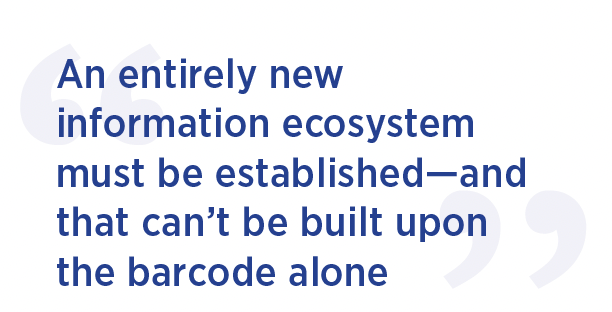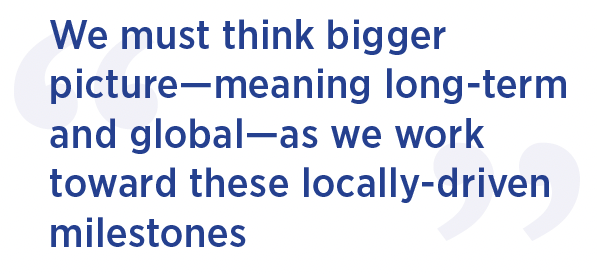New Serialization Mandates Inch Closer
Pressure is mounting ahead of looming unit-level serialization required by the Drug Supply Chain Security Act—necessitating a wide scope of collaboration on compliance
One of the strongest messages to come from this year’s Healthcare Distribution Alliance (HDA) Distribution Management and Expo Conference was that pharmaceutical manufacturers and distributors are genuinely afraid of what the FDA’s Drug Supply Chain Security Act (DSCSA) will do to their businesses. They’re also concerned about the consequences of noncompliance. Not just from a financial perspective, but from a global healthcare perspective. But this seems rather odd. The pharmaceutical industry is no stranger to regulation. So why are pharma executives, operations managers, and even IT leaders so afraid of this one?
Based on conversations with both manufacturers and distributors in the last several weeks, it seems this mandate is proving to be one of the most disruptive events in recent history, despite the time the industry has had to prepare. That says a lot considering the COVID-19 pandemic’s impact on pharma.
The truth is that most other regulatory requirements can be satisfied with barcode scans. Not DSCSA—at least not easily. Detailed data about each item in each package or pallet must be accurately logged and accessible throughout the entire supply chain so those items can be traced from the first mile through the last, and everyone can be confident their integrity has been maintained. This type of unit-level serialization is unprecedented, even if traceability regulations are not.

The reality is that an entirely new information ecosystem must be established—and that can’t be built upon the barcode alone. New sensor technologies must be integrated on the front lines and connected into back-end business systems. And the data captured must be clean before it flows downstream. So, it’s not like you can just put radio frequency identification (RFID) tags on products and replace barcode scanners with RFID readers. That will be the necessary first step, but not the only step. If it were, it would be quite a simple process given RFID’s maturity and proven compatibility with pharma products in the last few years.
So, what do pharma company leaders plan to do? Forget about competition and cooperatively strategize, test, and implement technology-based solutions as fast as possible. In fact, some are already doing so.
We must work together, as one company’s failure to comply could impact us all
The big three pharma manufacturers are working with the big three pharma wholesalers to get ready for the DSCSA November 2023 deadline. They’ve self-imposed a November 2022 deadline to ensure they have plenty of time to work out any issues in data capture, filtering, or distribution. This is not a situation where you can launch with a minimum viable product (MVP) and refine later. Once the mandate takes full effect at 12:01 a.m. on Nov. 23, 2023, any product that’s noncompliant will get stopped in transit. If pallets of temperature-sensitive medications are sitting outside the dock door at a downstream distribution point in the hot sun, that’s where they’ll stay until clean, electronic product code information services (EPCIS)-filtered data correlating with those products is available in the recipient’s system. No one is going to take the risk of accepting, transporting, or further distributing noncompliant goods.
While it’s good to hear these companies—many of which are competitors—are collaborating on a solution, we need to ensure no one is left behind. That means cooperation needs to extend far and wide across pharma and technology, and possibly beyond the private sector, similar to what we’re seeing occur with The Axia Institute-led pharma consortium.
Based on the Serialization Readiness Survey the HDA conducted in 2021, only 45% of manufacturer respondents said they’re currently meeting the pallet aggregation prerequisite for sending serialized transaction data. Over half thought this would be accomplished by the end of 2019. Furthermore, only 40% of manufacturers were expecting to send at least some serialized data to their wholesale distributor customers upon shipment by the end of 2021. We’ll see where they land in a few months, but what worries me is that 16% didn’t even know when they’ll exchange data, while the rest, though confident they’ll meet the FDA’s 2023 deadline, still don’t have a definitive date. They’re running out of time fast.
It’s not just about the deadline
Executives who participated in a globally fielded Pharmaceutical Supply Chain Vision Study commissioned by Zebra last year cited “investments in technology to track medications from plant to patient” as the top industry priority. They expect investments in pharmaceutical supply chain monitoring tools to rise in the coming months and years, too. But not just because they’re being told by government agencies like the FDA or European Union that they must improve product traceability or comply with certain data capture and reporting requirements. These industry leaders agree technology utilization improves business operations, especially supply chain optimization, and helps ensure proper handling, transportation, and storage, which reduces many different types of business and safety risks and helps maintain a healthy and strong supply chain.
For example, the Falsified Medicines Directive has been in effect for a while. Yet over 80% of pharma decision-makers in Europe, the Middle East, and Africa (EMEA) say government/regulatory agencies and pharmaceutical industry companies need to work better together to protect patients and help ensure the medications are safe and effective. They also agree that pharmacies need to monitor the quality and integrity of medications dispensed (i.e., check for contamination, falsification/counterfeiting) to ensure safety and effectiveness.
Plus, they’re receiving extreme pressure from an unexpected source: patients.

Eight in 10 patients now expect drug manufacturers to disclose how their medications are manufactured/handled and transported/stored. Patients also want to be able to verify the sources of medication ingredients, whether they are sustainable sources, and the techniques by which the manufacturer is protecting the environment, animal welfare, human communities, and public health. Manufacturers will not be able to maintain this level of communication and accountability without making changes to how they capture, aggregate, and further distribute data. Their legacy systems just weren’t designed for operational transparency on a public level. Honestly, the systems weren’t even capable of providing full transparency to internal stakeholders and decision-makers. That’s been the root issue of many supply chain problems these past few years.
Half of pharma decision-makers realized during the pandemic that they must do a better job of identifying vulnerabilities, risks, and failure points and adjusting inventory to meet fluctuations in demand. And, five years from now, over one-third want to be at the point where they can either be responsive to digital signals throughout the supply chain or say, “digital transformation is the way of the business.” Another quarter want to at least be integrating enterprise-wide systems for greater visibility.
For now, though, pharma entities know they must do everything they can to ensure they’re digitally flowing medication information and supply chain history data to patients—it’s a competitive advantage. At the same time, they must work to achieve a steady state in product quality and flow if they want to restore patients’ trust in pharmaceuticals.
The global movement toward new track-and-trace systems is starting in the last mile
Patients are very aware that a compromised supply chain puts medication quality and efficacy at risk, and medication authenticity is the top reason patients search for information about what they’re taking or being given. Nine in 10 want assurances a medication is not counterfeit and hasn’t been tampered with. They also want to be able to confirm themselves that temperature-sensitive medications have stayed within the prescribed range.

Safety concerns aren’t the only thing on patients’ minds, though. They’re not confident they’ll be able to get the medications they need when they need them—mainly because they’ve been facing this issue already. Changing pharmacies is one tactical solution. But if pharma manufacturers and distributors don’t figure out how to capture, transmit, and receive clean, EPCIS formatted data by November 2023, product won’t move, and pharmacies will see empty shelves, at least in the US. Over 300 million people will potentially be impacted—and inspired to act when they realize there’s no workaround to this problem other than calling on pharma companies to get their traceability systems working. Of course, even if every company is DSCSA-compliant by November 2023 and the regulation becomes a non-issue, there are other supply chain bottlenecks that must be cleared.
One-third of patients are already reporting drug availability issues, and a quarter worry that there will be a slow response to recall defective medications and treatments if changes aren’t made to the supply chain. Around 70% are concerned they’ll receive products that were improperly handled/stored during transit and could have damage or diminished efficacy.
So, it’s not a government mandate that’s going to create a culture of data quality and integrity or motivate the changes needed to build a safer, more agile, and resilient supply chain. It’s the public mandate. Many pharma leaders would agree. That’s why we must think bigger picture—meaning long-term and global—as we work toward these locally-driven milestones.
About the Author

John Wirthlin is Industry Principal, Manufacturing, Transportation, and Logistics, Zebra Technologies.
